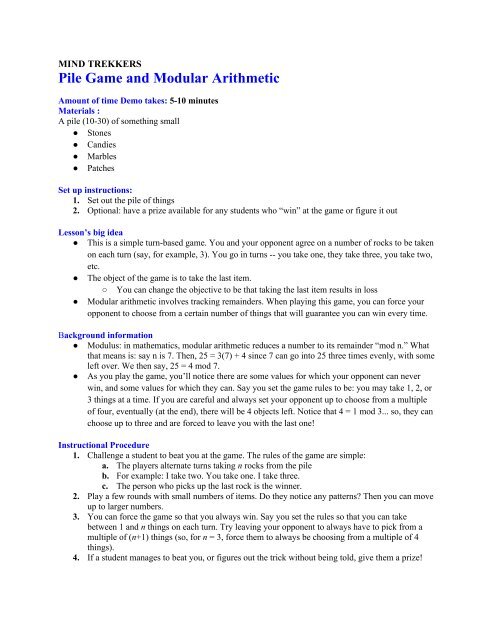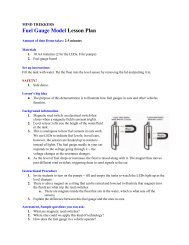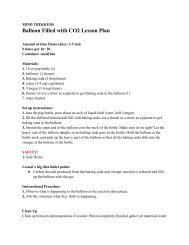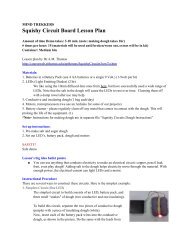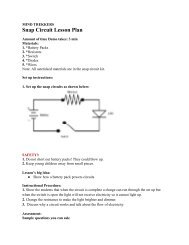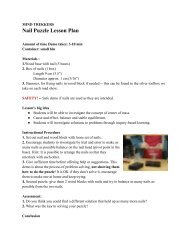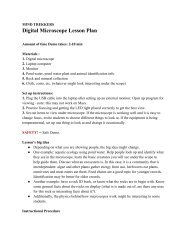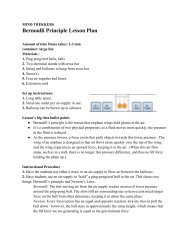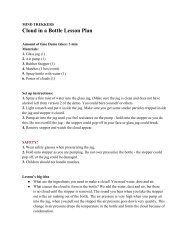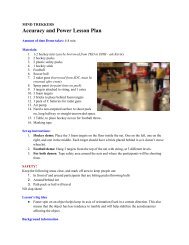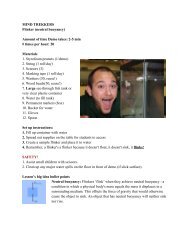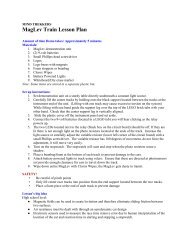Pile Game and Modular Arithmetic - MTU Mind Trekkers
Pile Game and Modular Arithmetic - MTU Mind Trekkers
Pile Game and Modular Arithmetic - MTU Mind Trekkers
Create successful ePaper yourself
Turn your PDF publications into a flip-book with our unique Google optimized e-Paper software.
MIND TREKKERS<strong>Pile</strong> <strong>Game</strong> <strong>and</strong> <strong>Modular</strong> <strong>Arithmetic</strong>Amount of time Demo takes: 5-10 minutesMaterials :A pile (10-30) of something small● Stones● C<strong>and</strong>ies● Marbles● PatchesSet up instructions:1. Set out the pile of things2. Optional: have a prize available for any students who “win” at the game or figure it outLesson’s big idea● This is a simple turn-based game. You <strong>and</strong> your opponent agree on a number of rocks to be takenon each turn (say, for example, 3). You go in turns -- you take one, they take three, you take two,etc.● The object of the game is to take the last item.○ You can change the objective to be that taking the last item results in loss● <strong>Modular</strong> arithmetic involves tracking remainders. When playing this game, you can force youropponent to choose from a certain number of things that will guarantee you can win every time.Background information● Modulus: in mathematics, modular arithmetic reduces a number to its remainder “mod n.” Whatthat means is: say n is 7. Then, 25 = 3(7) + 4 since 7 can go into 25 three times evenly, with someleft over. We then say, 25 = 4 mod 7.● As you play the game, you’ll notice there are some values for which your opponent can neverwin, <strong>and</strong> some values for which they can. Say you set the game rules to be: you may take 1, 2, or3 things at a time. If you are careful <strong>and</strong> always set your opponent up to choose from a multipleof four, eventually (at the end), there will be 4 objects left. Notice that 4 = 1 mod 3... so, they canchoose up to three <strong>and</strong> are forced to leave you with the last one!Instructional Procedure1. Challenge a student to beat you at the game. The rules of the game are simple:a. The players alternate turns taking n rocks from the pileb. For example: I take two. You take one. I take three.c. The person who picks up the last rock is the winner.2. Play a few rounds with small numbers of items. Do they notice any patterns? Then you can moveup to larger numbers.3. You can force the game so that you always win. Say you set the rules so that you can takebetween 1 <strong>and</strong> n things on each turn. Try leaving your opponent to always have to pick from amultiple of (n+1) things (so, for n = 3, force them to always be choosing from a multiple of 4things).4. If a student manages to beat you, or figures out the trick without being told, give them a prize!
Assessment, Sample questions you can ask:1. How can you win at this game?2. What happens when we change the number of rocks you can take at a time?3. How does your strategy change if you make it so that the person who takes the last item loses?Clean Up● Repackage all the rocks/c<strong>and</strong>ies/items.References● List any references used, <strong>and</strong> links for instructor to find more relevant information on topic orvideo to watch the demoNational K-12 Science St<strong>and</strong>ards● List by K-4, 5-8, 9-12 for each st<strong>and</strong>ard covered


